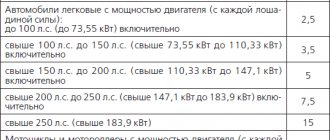From the name of the tax levy it is clear that it is paid by companies that own vehicles. This is a local, regional tax, and it is the local authorities who set the appropriate rate for it. All vehicle owners – both individuals and legal entities – must pay the duty on time. Chapter No. 28 of the Tax Code of the Russian Federation contains all the rules regarding the payment of transport fees. In the article we will tell you how to calculate transport tax for legal entities, coefficients, deadlines within which money must be transferred, and so on.
Transport tax for legal entities
Who should pay transport tax?
Payers of transport tax are companies where vehicles are registered. That is, taxes are paid by companies that have a car or other vehicle registered with the State Traffic Inspectorate. The obligation to transfer money to the state treasury remains in any case, even if the machine is not used for the direct needs of the company and does not generate income.
Typically, the tax is calculated on cars and trucks, as well as buses that are on the company’s balance sheet. But if a company has a specific type of activity, it will also pay a fee for another type of transport, for example, water transport. A yacht club that owns boats, cutters and yachts and offers them for rent has an obligation to the state to pay a fee.
We emphasize that only companies that own vehicles pay the fee. If a vehicle fleet is rented and construction equipment is leased, the obligation to pay the transport fee rests with the owner of the vehicles or equipment.
Features of the transport tax benefit
Payment of transport tax is not provided for owners of motor boats with engines whose power is less than 5 hp, and vehicles equipped for the disabled. Other preferential categories of citizens and transport are listed in Art. 361.1. Tax Code of the Russian Federation "Transport Tax". To receive a transport tax benefit, a citizen must submit an application with supporting documents to the relevant tax authority.
The tax period for payment of transport tax is a calendar year. For enterprises that own vehicles, the tax periods include the first, second and third quarter. A notice of payment of transport tax must be sent to the taxpayer no later than 30 days before the end of the payment deadline.
How to calculate and pay?
Compared to individuals who, at the end of the annual tax period, receive a notification about the need to pay the transport fee and its amount, legal entities are required to independently calculate the amount to be paid. The calculations made are included in the declaration, which must be submitted to the inspectorate at the place of registration of the LLC. Documents documenting transport fee reporting from legal entities are accepted by the inspectorate no later than the first February working day of the year following the reporting year. The tax, as we have already said, is local, which means that regional authorities can provide for the payment of preliminary (advance) payments. They are paid to the treasury quarterly, but there is no need to submit a declaration on them to the inspectorate.
Just like for ordinary citizens, for legal entities the transport tax is calculated using a simple formula: the tax base multiplied by the rate. Let's figure out where to get these indicators from. The rate is set for a specific type of transport according to an important criterion - the power of its engine. The amount of tax is directly related to this indicator - the more powerful the transport, the higher the rate on it, and the higher the tax. The engine power is found out in an elementary way - it is indicated in the vehicle passport (PTS).
The rate is not fixed for the entire country - each region has the right to change the value, making it less or more. But local authorities are somewhat limited in this matter, since they do not have the right to increase or decrease the rate by more than ten times compared to the federal one. To find out at what rate the tax is calculated in a particular subject of the country, just go online or contact the tax office.
Increase or decrease factors can be added to the calculation formula. The increasing coefficient (Kp) applies to expensive cars, the price of which is more than three million rubles. The coefficient also depends on the period of use of the car after its release - the older the “elite” car, the less the tax will increase.
Table of coefficients increasing transport tax
For more information about transport tax and how to calculate it, read our article.
Calculation of transport tax for legal entities
We have already figured out that companies must calculate the amount of the fee themselves, without waiting for the Federal Tax Service to require them to submit a declaration. For each vehicle owned by the company, the tax is calculated separately. There are four things you need to know:
- tax rate;
- engine power;
- the time that the company owns the transport;
- whether it is necessary to apply reduction or increase factors.
Table 1. Examples of transport tax calculation
| Example No. 1 | Example No. 2 | Example No. 3 |
| Krug LLC owns a 2015 BMW car with an engine power of one hundred and two horsepower. The car cost one and a half million, so there is no need to apply an increase factor. The LLC operates in Sverdlovsk, where the rate for 2021 is 9.4 rubles. Accordingly, when multiplying the engine power by the rate, the annual tax amount is 958.8 rubles. According to tax rules, the figure will be rounded to 959. | purchases a Mercedes car from the showroom in March 2021, the power of which is one hundred and forty horsepower. This is a new car, its price is 3.2 million rubles, for this reason the increase factor comes into force. The company also operates in Sverdlovsk, where the authorities have approved a transport tax rate of 9.4 rubles. Thus, the tax for 2021 (do not forget that the car was purchased in March) will be 1,645 rubles. Therefore, a company that owns a vehicle for less than a full year must determine a coefficient for calculating the tax fee. To do this, you need to divide the number of months in which the company owns the vehicle by the number of months in the tax period - 12. This is called the “Q coefficient”. | If Triangle LLC owns a Mercedes for ten months, then the coefficient Kw will be 0.83. |
Video - Calculate and pay transport tax on a car
Calculation of preliminary payments
To calculate the advance quarterly tax payment, you need to use the formula specified in Article No. 362 of the Tax Code of the Russian Federation. It looks like this:
Tax base x tax rate x coefficient KP (if any) x coefficient Kv / 4 (number of quarters per year).
Let's look at an example. Moscow LLC "Kvadrat" is calculating an advance payment for a Honda car worth six hundred thousand rubles and a capacity of one hundred and twenty-five horsepower. Since the Kp coefficient is not applicable, and the transport tax rate for Moscow is 25 rubles, the formula looks like this: (125 x 25 x 1) / 4 = 781 rubles.
Exempt from paying tax
The law provides for conditions under which a company that owns a car can be exempt from paying tax. Read more about this in the table below:
| Kind of transport | Description |
| Agricultural equipment | If your company operates in the agricultural sector, then you are not required to pay tax on tractors, combines and other agricultural equipment. |
| Vehicles for transportation by water and air | Organizations operating in the field of passenger and cargo transportation have the right to avoid paying taxes on water and air transport. Carriers using cars and trucks are not exempt from paying the tax. |
| Transport for disabled people | If your organization employs disabled workers and owns transport equipped for citizens of this category, then you do not have to pay tax on it. |
| Low power boats | There is no obligation to pay tax for organizations that own motor or rowing boats up to 5 l/s. |
We will pay special attention to the tax obligations of legal entities in cases where the object of taxation (transport) is stolen. If a car owned by your company was stolen, then you have the right not to pay tax. The legal grounds for this are documents confirming the fact of theft (for example, a certificate issued by the Ministry of Internal Affairs stating that the car is wanted). From the beginning of the year (or from the date of registration of the car, if it was purchased in the middle of the reporting period) and until the moment of theft, the company has obligations to pay tax; from the date of the theft, according to the certificate, until the moment the vehicle is returned to the owner, the company has a legal exemption from paying tax.
Deadlines for payment of transport fees
Regional authorities have the right to independently set the terms within which transport owners will transfer payments. But, according to Chapter No. 362 of the Tax Code of the Russian Federation, this deadline cannot be set earlier than the first working day of February (most often this is the first day of the month). Advance payments, as we have already figured out, are due quarterly. But upfront payments are not required for regional installations. If the authorities do not require payment of the tax four times a year, then the entire amount is paid in one lump sum.
LLCs owning heavy trucks may qualify for benefits
TN for legal entities: basic requirements
The basic principles for calculating TN for private car owners and commercial companies are identical: this is a regional fee, which is regulated by local legislation. The calculation formula looks like this:
Tax amount = tax rate * tax base. Where:
- The rate is a figure approved individually by each Russian region, taking into account the category, year of manufacture, capacity and engine power of the vehicle. If the regional legislation does not contain a provision on the regional TN rate, the base rate is automatically applied (Article 361 of the Tax Code), which local budgets have the right to increase or decrease up to 10 times.
- The tax base is a figure that takes into account the power of the vehicle in “horses”:
| Power (hp) | Rate per 1 HP (rub.) |
| up to 100 hp | 2.5 |
| 100-150 hp | 3.5 |
| 150-200 hp | 5 |
| 200-250 hp | 7.5 |
| over 251 hp | 15 |
The calculation formula may vary depending on the characteristics of the car and the period of its use. In particular, if the car has a cost above 3 million rubles, the amount obtained from the formula should be multiplied by a multiplying factor:
| Price, million rubles | Car age | Increasing factor |
| 3-5 million rubles | up to 3 years | 1.1 |
| 5-10 million rubles | up to 5 years | 2 |
| 10-15 million rubles | up to 10 years | 3 |
| More than 15 million rubles | up to 20 years | 3 |
That is, for a car in the price category of up to 5 million rubles, a commercial company will pay 10% more for 3 years, and for an old and very expensive car you will have to pay three times more for 20 years.
If the company does not own the car for a full calendar year, then the formula is multiplied by the ownership coefficient (12 months / X months of ownership). The month is determined by the 15th day: if the car is registered before the 1st day, the month is counted as ownership, if later, it is not taken into account.
In addition, from the formula it may be necessary to subtract the amount of benefits provided by law and property deductions in the amount of fines paid for the period if the company works with the Platon system.
Transport fee: changes
Since the beginning of 2021, a number of changes have occurred in Russia regarding the payment of vehicle tax for LLCs:
- According to Chapter No. 362 of the Tax Code of the Russian Federation, the list of expensive cars posted on the website of the Ministry of Industry and Trade applies only to the period in which it is posted. There is no need to recalculate the amount of the fee for previous years.
- The procedure for calculating the ownership coefficient (Kv) has been clarified according to the information we provided above (full months of ownership to the number of months in a year). Now a full month is considered to be the one when the vehicle was purchased before the fifteenth day or deregistered after the fifteenth day.
- A tax deduction has appeared for heavy vehicles, the amount of which is equal to payments for damage caused to roads by heavy vehicles. Thus, the tax levy for “heavy cargo” can be reduced completely, to zero.
List of passenger cars with an average cost of 3 million rubles for the 2021 tax period
We calculate the amount of tax payment
In order to determine the amount of tax payment to the budget, you will need two indicators:
- vehicle engine power (MoschDv);
- tax rate (St).
The tax is calculated as the product of the above indicators:
TrN = PowerDv * St
To calculate the tax, you need to know the engine power in horsepower. You can obtain this information in vehicle registration documents (for example, in a registration certificate).
The tax rate used for calculation is determined based on the first indicator - engine power. To determine the amount of transport tax payment, not an ad valorem rate (in percentage), which is usual for many tax calculations, is used, but a fixed rate - an amount (in rubles) for each horsepower. The more powerful the engine of a car owned by your company, the more tax you will have to pay to the budget.
Please note that transport tax is included in the category of regional payments, therefore the size of the tax burden on payers is determined by the legislative acts of a particular region. In order to find out what the rate is for transport registered to a legal entity in your region, contact your local administration.
If the car has been owned for less than a year
If your company purchased a car within a year, you are recognized as a tax payer from the moment the vehicle is registered. In this case, the budget payment is calculated in proportion to the period of ownership of the vehicle. In this case, you should remember the following rules:
- if a car is registered to a company between the 1st and 15th of a month, then this month must be included in the taxable period. Similarly in the case when the car is deregistered between the 16th and 31st of the month;
- When registering a car after the 16th day, this month is not included in the calculation. Also, the month of use of the car does not take into account the period in which the vehicle was deregistered before the 16th.
Example No. 1.
In March 2021, Scarabey LLC (Kaluga) purchased a Chevrolet Cruze (140 l/s). 03/14/2016 Chevrolet Cruze was registered with the traffic police.
03.11.2016 “Scarab” deregisters the Chevrolet Cruze car in connection with its sale by JSC “Timer”.
The accountant of Scarabey LLC calculated the transport tax as follows:
- The accountant determined the period of actual ownership of the Chevrolet Cruze car to be 8 months (March - October 2016). Since the car was purchased before March 15, 2016, March is included in the tax period. November 2021 is excluded from the calculation, since the car was deregistered until 11/15/16;
- The tax rate for Chevrolet Cruze (140 l/s) in Kaluga is set at 25 rubles. for every horsepower;
- the tax amount for the full year is calculated in the amount of 3,500 rubles. (140 * 25);
- since “Scarab” used a Chevrolet Cruze for 8 months, tax must be paid to the budget in the amount of 2,333 rubles. (3,500 rubles / 12 months * 8 months).
We take into account the increasing coefficient
Currently, many large companies purchase premium cars, the cost of which often exceeds 3,000,000 rubles. If your company owns a car of this category, then you should know that the amount of tax on this vehicle increases in proportion to the increasing coefficient.
In order to find out whether the company’s transport belongs to the group of premium cars, check out the corresponding list posted on the website of the Ministry of Economic Development. The list of cars is updated annually in accordance with the market situation. When calculating tax for 2016, use the list published in 2021 (usually the register is posted on the website in March of each year).
Please note that the increasing coefficient is set at a uniform rate for all regions of the Russian Federation; it cannot be changed by legislative acts of various constituent entities of the Russian Federation. The coefficient varies depending on the cost of the vehicle and the period of its operation.
Example No. 2.
JSC President (Tula) owns a BMW x5 (306 l/s). The car is used by the head of the “President” to attend executive meetings, accompany partners, etc.
When calculating the tax on a BMW x5 car, the President’s accountant used the rate accepted for this vehicle in the Tula region - 150 rubles. / hp Also, the calculation took into account a coefficient of 1.1, since the car was produced 2 years ago.
The amount of tax to be paid for the year was determined as follows:
306 l/s * 150 rub. * 1.1 = 50.490 rub.
Determining the amount of the quarterly advance
The law obliges legal entities that own vehicles to pay the tax in advance. Payments must be made quarterly. The deadline for making an advance tax payment is set by the regional authorities. As a rule, funds must be paid no later than the end of the month following the reporting month (for the 1st quarter - before the end of April, etc.). The deadline for final tax settlement is the same for all subjects of the Russian Federation - until February 1 of the next year, similarly - for filing a tax return with the local Federal Tax Service
In order to determine how much advance payment your organization should transfer to the budget, you need to calculate the amount of the annual payment, and then divide it into 4 periods (quarters). The final payment is made at the end of the year upon filing the declaration based on the data specified in it. To determine the size of the last payment, you need to subtract the amount of the transferred advances from the annual amount.
Example No. 3.
Santim LLC (Tver) owns a Mitsubishi colt (107 l/s) car.
In January 2021, the accountant of Santim LLC calculated the amount of tax for the coming year:
107 (power) * 21 (rate for this category of car in Tver) = 2,247 rubles.
On 04/08/16, 07/12/16 and 10/05/16, the Santima accountant transferred the amounts of advances - 562 rubles each. (RUB 2,247 / 4).
On 01/18/17, the Santima accountant submitted a declaration to the Federal Tax Service, which indicated the tax amount of 2,247 rubles. On January 22, 2017, the balance of the tax for the Mitsubishi colt car, 561 rubles, was transferred to the budget. (2,247 rubles – 562 rubles * 3).
How to calculate the amount for individual entrepreneurs
Individual entrepreneurs are individuals engaged in business activities that are registered as individual entrepreneurs, and not as a legal entity or farm.
According to Article 357, private entrepreneurs calculate the transport tax themselves for self-checking.
They pay according to the notification that comes to them, just like for individuals. Therefore, an individual entrepreneur is subject to all tax calculation rules and, when paying, acts in the same way as all other individuals.
Therefore, entrepreneurs do not need to use formulas to calculate advances. For self-testing, he can apply a formula to calculate the annual payment (with or without a multiplying factor).
We can confidently say that the formulas for calculating transport tax are quite simple, and collecting data for calculations will also not be difficult.
The only thing that may pose difficulties is the confusing practical situation with the status of the car itself, as well as orientation among tax rates.
Still, the transport tax uses differentiated tax rates, which differ from region to region.
Find out what documents are needed to receive transport tax benefits from the article: documents for transport tax benefits. Where to pay transport tax on a car, read here.
How to pay the transport tax on a motorcycle is discussed on the page.
Payment period
The procedure for paying transport tax payers money into the budget is established by Art. 363 Tax Code of the Russian Federation. The norm establishes the basic rules for advance and final contributions. The exact schedule for an LLC is established by regional law.
Calculations must be completed before filing the declaration - February 1 of the following year. The deadlines for an organization to submit a transport tax report to the fiscal authority are determined by Art. 363.1 Tax Code of the Russian Federation. Unless a different procedure has been established by the region, firms transfer advances to the budget quarterly. Each payment is equal to a quarter of the total amount for the year.
In conclusion, we note the need for a detailed study of local regulations. Regulatory acts of the constituent entities of the Russian Federation introduce not only rates, but also describe the procedure for obtaining benefits. Timely review of documents allows you to optimize the fiscal burden.
What data is needed
All legal entities that are owners of vehicles are taxpayers and must pay the transport tax in a timely manner to the budget of the constituent entity of the Russian Federation in the territory in which the enterprises are registered (Article 357 of the Tax Code of the Russian Federation).
The law obliges legal entities to calculate the amount of transport tax, pay, monitor timely payment and submit vehicle declarations - independently.
In other words, none of the tax inspectors will come to your office to calculate the amount of tax, and no one will send you an email notification about the deadlines for payment.
The amount of tax for organizations is calculated for each vehicle separately and includes a number of related factors that significantly affect the amount in the end.
The amount payable under tax legislation for a particular vehicle is formed by multiplying the tax base, which is in accordance with the parameters of the vehicle and the tax rate, which is of two types: basic and regional.
In order to have a good understanding of what the transport tax depends on, it is enough to simply look at the list of data from the regulatory tax base, which are taken into account in the calculation process:
- Vehicle engine horsepower. First of all, attention is paid to the engine power of the taxable vehicle. It is usually indicated in the car’s passport in kilowatts, but in the calculation formula it must be in horsepower, so watts are converted to the required unit of measurement for the calculation to be correct.
- If the vehicle is airborne and has jet engines, then the measure will be kilograms of force.
- For non-self-propelled water transport, gross tonnage is taken into account, which is measured in register tons.
- A unit of transport for calculations for other types of transport for travel on water or by air.
To determine the tax base in each individual case, Art. 359 of the Tax Code of the Russian Federation.
If the documents of a particular transport do not contain any information necessary for calculating the transport tax, then an examination is carried out in accordance with a certain procedure, which is specified in Art. 95 Tax Code of the Russian Federation.
In addition to the tax base, the amount of the tax can also be affected by the increasing coefficient for expensive cars, which from 2021 legal entities are required to take into account when calculating transport tax (clauses 2 and 2.1 of Article 362 of Federal Law No. 214-FZ of July 23, 2013 G.).
This means that the price of the car also has an impact on the size of the tax payment.
Thus, the law has adopted the following increasing coefficients, which are used in calculations in 2021:
| for cars produced in 2012-2013 (2-3 years ago) | costing from 3 million rubles. up to 5 million rubles | 1.1 rub./1 hp |
| for cars produced in 2021 (one year ago) | costing from 3 million rubles. up to 5 million rubles | 1.3 rub./1 hp. |
| for cars manufactured since 2021 (less than a year ago) | costing from 3 million rubles. up to 5 million rubles | 1.5 rub./1 hp |
| for cars produced in 2009 (5 years ago) | from 5 million rubles up to 10 million rubles | 2 rub./1 hp. |
| for cars produced in 2005 (10 years ago) | costing from 5 million rubles. up to 10 million rubles | 3 rub./1 hp. |
| for cars produced in 1995 (20 years ago) | costing from 5 million rubles. up to 10 million rubles | 3 rub./1 hp. |
The coefficient should be taken based on the amount of time in years from the date of production of the car until the moment the transport tax is calculated.
Thus, we see that with each year or period of time, the period of use will increase, and the size of the increasing factor will increase in accordance with accepted standards by law.
The service life can also influence the formation of the tax rate, which is included in the calculation formula.
Despite the fact that tax rates are ready-made figures and legal entities do not need to calculate them, they are set differently for one region or another and depend on the following criteria (as does the tax base):
- vehicle engine power;
- the category to which the vehicle belongs;
- gross tonnage;
- service life of the vehicle.
All tax rates are taken from tables for each region of the country separately, so legal entities always use such data to calculate transport tax, taking them from the table for their region.
How to find out the transport tax debt is explained in the article: find out the transport tax debt. You can find a sample form for filling out an application for a transport tax benefit here.
Period and procedure of payment
TN must be paid before December 1 of the year following the reporting year . During the reporting period, the organization can contribute part of the amount as an advance, which is taken into account when determining the total amount.
In case of violation of the established payment terms, penalties are applied to the guilty person.
Advance fees
Payments of this nature are made quarterly. At the regional level, legal entities may be exempt from making an advance payment. The timing of such payments is established by the authorities of the constituent entities of the Federation. The amount of the advance is a quarter of the total tax amount. We wrote in more detail about advance payments in a separate article.
Late fees
For violation of payment deadlines, penalties are imposed on a legal entity. Their size depends on the duration of the delay. If it does not exceed 30 calendar days, then 1/300 of the refinancing rate is charged for each day, if more than 30 days, then 1/150.









